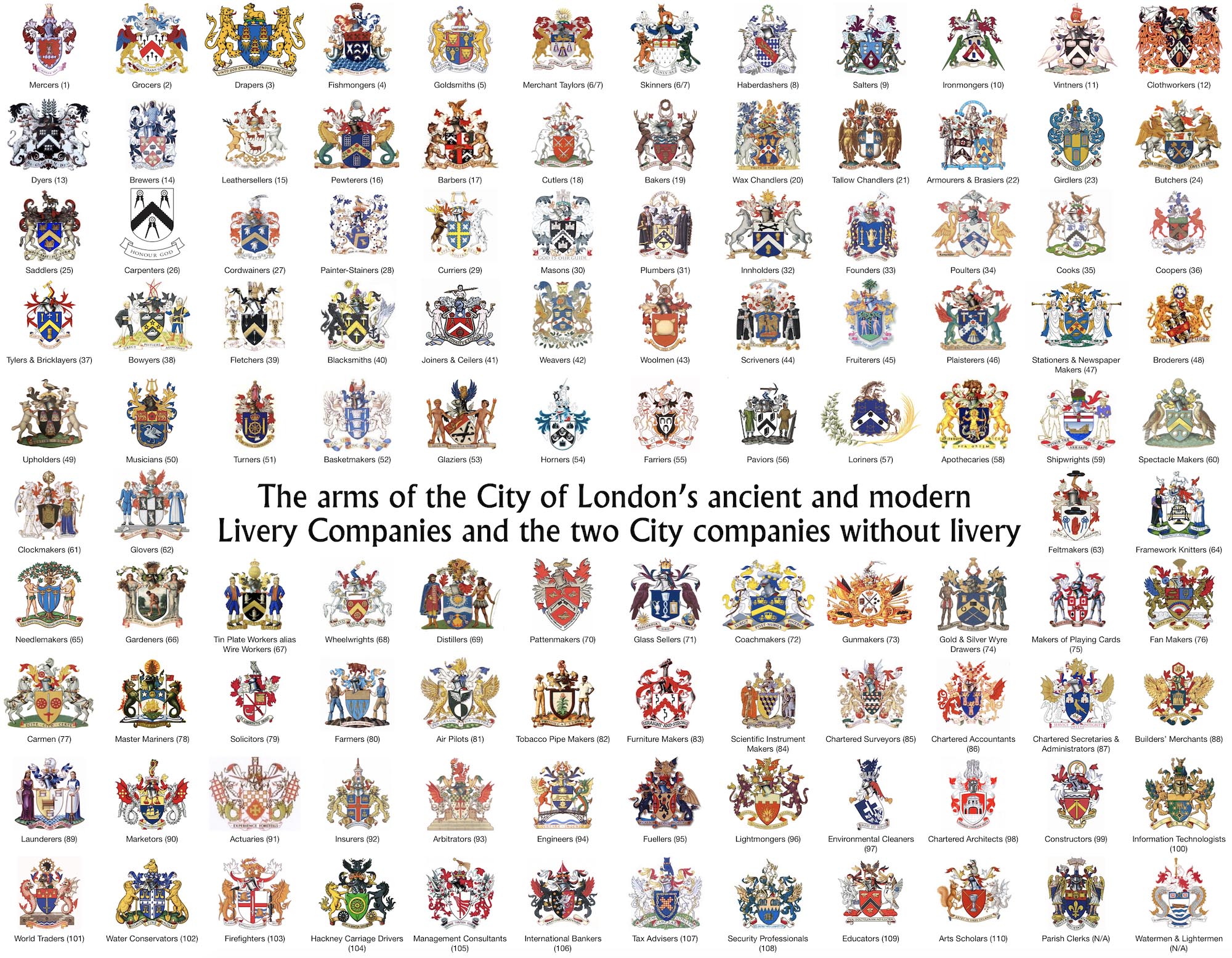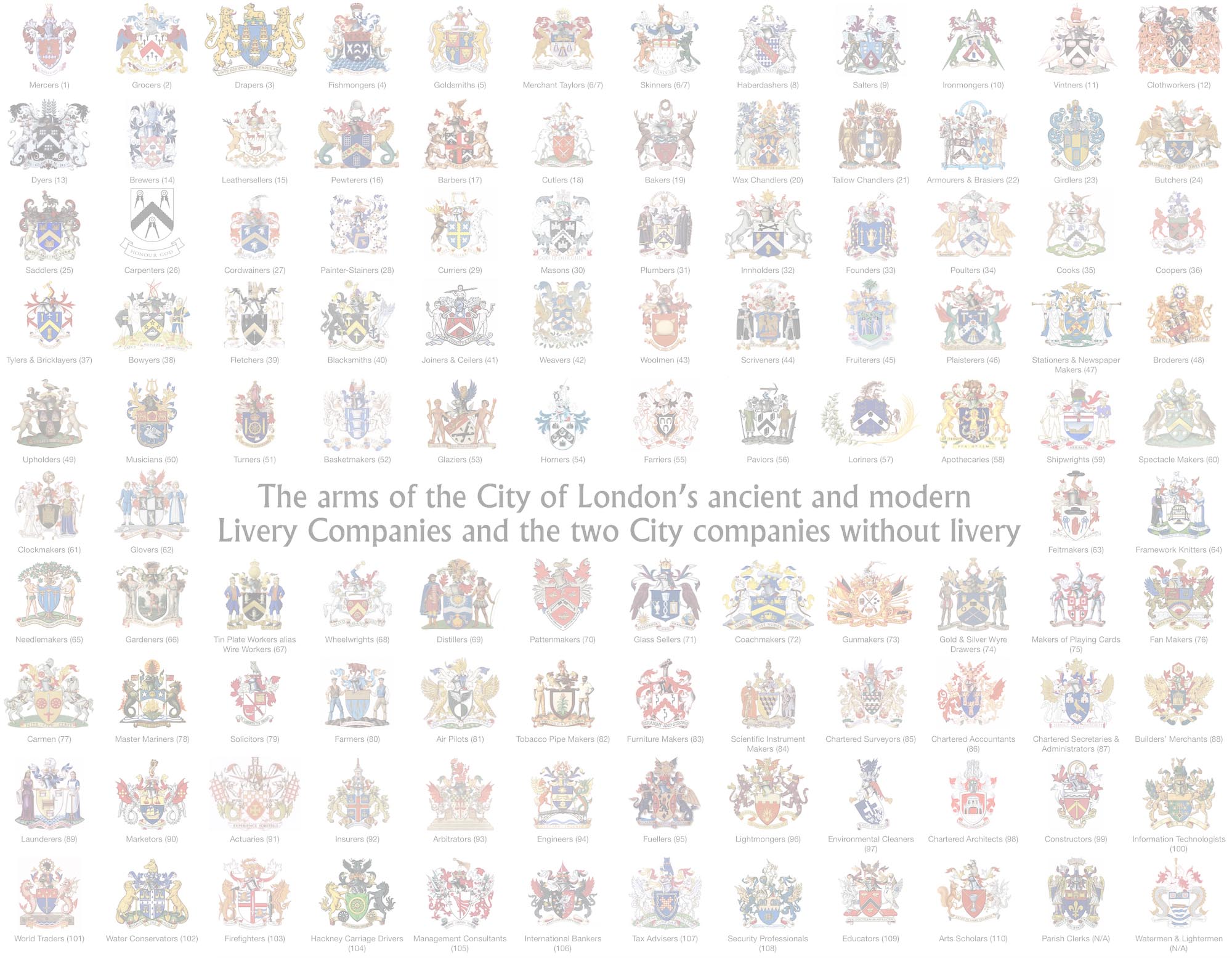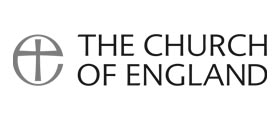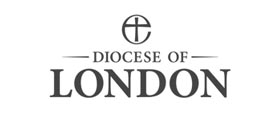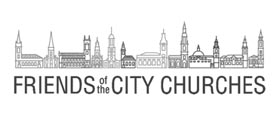What Is A Livery Company?
The Livery Companies probably had their origins in this country before 1066. The early Guilds (or mysteries, from the Latin ‘misterium’, meaning professional skill) were the medieval equivalent of trading standards departments, checking quality of goods and weights and measures. They also controlled imports, set wages and working conditions and trained apprentices. Many of today’s sayings have originated from Livery Companies:
“On tenterhooks” arose from the double-ended hook in the Clothworkers’ arms;
“A baker’s dozen” reflected the practice of adding a thirteenth roll to the dozen to avoid accusation of short-changing;
“Sent to Coventry” – Liverymen expelled from a London Guild went to Coventry, a “free-town”, where Guilds had no influence.
The word ‘guild’ derives from the Saxon word for payment, since membership of these fraternities was (and is) paid for. These trades tended to congregate in a common area for both practical and material convenience and many streets within the City of London reflect this origin, for example, street names – such as Milk Street, Bread Street, Ironmonger Lane, Coopers Passage, Poultry, Cloth Fair and Mason’s Avenue – mark the sites where it all began.
To strengthen their position, the Guilds would apply for incorporation by Royal Charter. Besides establishing a Company and its rights over trade, a Charter granted the right to wear ceremonial robes – unique to each Company – known as a ‘livery’. This granting of Charters became a lucrative way of raising funds for the Crown.
For centuries Livery Companies exercised virtual monopolies over trade in the City. Each Company had the right to inspect its own trade, and to impose heavy fines on anyone whose goods or services were inferior. The power of the Livery Companies only began to decline as London grew, and craftsmen moved out and into the new suburbs beyond the effective reach of the Guilds.
Livery & Religion
The welfare of their members, both spiritual and material, was a major concern for the Guilds. Members received help in sickness and in many cases almshouses were established. There was a strong religious connection, with each Guild having a Patron Saint and also a link with a church or monastery, where regular Guild Services would be held and prayers said for departed members. Funerals were particularly important occasions, attended by all members of the company.
Livery & The Reformation
Before the Reformation, more than half of the area of London was occupied by monasteries, nunneries and other religious houses, and about a third of the inhabitants were monks, nuns and friars. During the reign of Henry VIII, as the crown broke away from the catholic faith and established the Church of England, these places were confiscated and effectively sold to the highest bidder. This was not a healthy climate within which to be associated with the pursuit of religion or popish religious symbolism. Prudently, many of the companies’ arms were discreetly altered at this time, as the emphasis of the Guilds shifted more to the development of trade. For example, the Baker’s Company arms originally bore the triple crown of the Pope, but by 1536 this had been changed to sheaves of corn.
The Role of the Livery Company Today
Health
One of the first charitable tasks undertaken by the early Guilds was to care for their members in sickness and old age. Many Livery Companies still support or maintain almshouses for elderly people throughout the country.
The best known name in the history of the City of London was responsible for one of these long-lived trusts. Richard Whittington, 4 times Mayor of the City of London, and a Mercer, who died in 1423, left property worth at the time some £6,000 (the equivalent of many millions today) for almshouses. The trust still exists and has a substantial income which provides comfort and dignity for elderly people and others in need.
Education
Almost from their earliest times the ancient Guilds undertook a responsibility for the education and training of young people. Training apprentices in the skills of their craft or trade was an important part of a liveryman’s duties. Modern Livery Companies actively promote apprenticeship schemes as the best way to provide thorough training, especially in the specialised technical skills which are in demand today.
The Livery has been involved in university education for many centuries, often as founder or funder of the more ancient institutions. Companies also helped to found technical colleges or institutes and support continues whether it be financially, or by the supply of equipment, together with scholarships and bursaries enabling young people to study for scientific and technical careers. One of the best known examples of the Livery contribution towards higher and vocational education is the City & Guilds London Institute, which was founded in 1878 by the City of London and 16 Livery Companies. It has since received ongoing support from the Livery.
The majority of Livery Companies have also formed close links with schools, whether this by providing a governor to advise on financial and management issues, or by support in kind for project work, or by financial help for things the school budget cannot support.
Wealthy Liverymen or their widows often set up trusts to found schools which were left to their Company to administer after their death. Many of these still survive, such as Greshams ( linked to The Worshipful Company of Fishmongers), Haberdashers’ Aske’s School, (funded originally by a bequeathment from Robert Aske), the St Paul’s school ( founder John Colet), Merchant Taylor’s school,( founder Sir Thomas White, cloth merchant) and Londonderry College, Northern Ireland. The original trusts still provide support for most of them.
